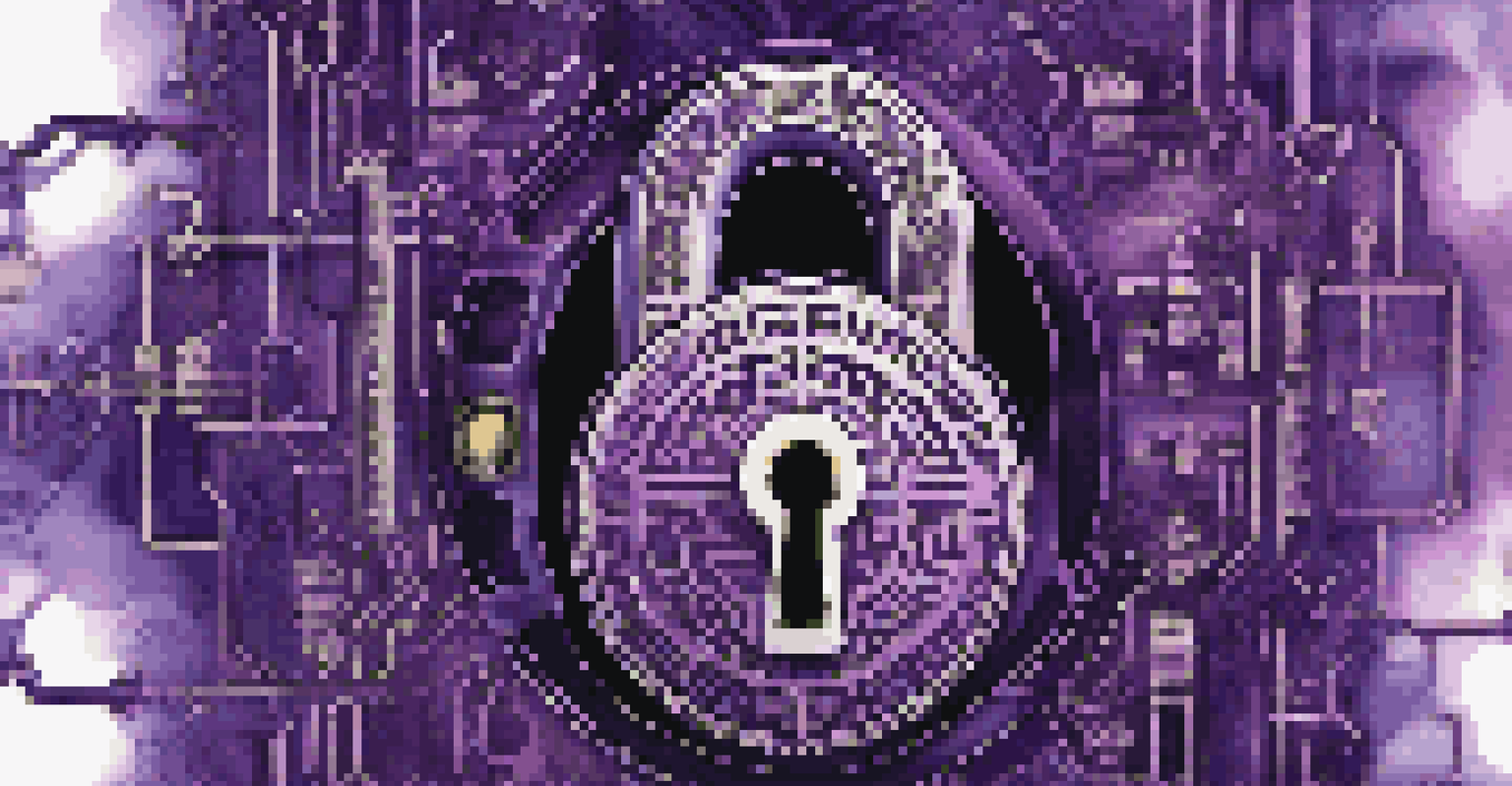The Intersection of Smart Contracts and Cryptography

Understanding Smart Contracts: The Basics Explained
Smart contracts are self-executing contracts with the terms directly written into code. Imagine them as digital vending machines: once you insert the right coins, the machine automatically delivers the product without needing a middleman. This automation is what makes smart contracts appealing, especially in blockchain technology, where trust and transparency are paramount.
Smart contracts are not a magic bullet, but they can eliminate a lot of the inefficiencies in our current system.
The concept of smart contracts was popularized by Ethereum, which allows developers to create decentralized applications. These contracts can handle everything from financial transactions to property agreements, ensuring that all parties adhere to the terms without intervention. By eliminating intermediaries, smart contracts can reduce costs and increase efficiency.
However, while smart contracts are innovative, they are only as secure as the underlying technology that supports them. This is where cryptography comes into play, providing the necessary tools to ensure the integrity and confidentiality of transactions. Understanding this relationship is crucial for anyone interested in blockchain technology.
The Role of Cryptography in Securing Smart Contracts
Cryptography is the science of securing information, and it plays a critical role in the functionality of smart contracts. At its core, cryptography ensures that data remains private and unaltered during transactions. Think of it as a lock and key: only those with the right key can access certain information, making it highly secure.

In the context of smart contracts, cryptography helps verify the identities of users and ensures that the contract's terms cannot be tampered with. This is achieved through techniques like hashing, which creates a unique fingerprint of the data. If even a single character changes, the hash will differ, alerting everyone involved that something is amiss.
Smart Contracts Automate Transactions
Smart contracts function like digital vending machines, executing agreements automatically without the need for intermediaries.
Moreover, cryptographic algorithms like public and private keys provide a secure way to execute transactions. Users can sign contracts digitally, ensuring authenticity and preventing fraud. This marriage of smart contracts and cryptography creates a robust framework for secure digital transactions.
Decentralization: How It Enhances Security
One of the most significant advantages of both smart contracts and cryptography is decentralization. This means that no single entity has control over the entire system, making it harder for bad actors to manipulate or corrupt the data. Imagine a library where every book is copied and distributed across multiple locations; if one copy is damaged, others remain intact.
Cryptography is the backbone of a secure digital world, ensuring that trust is built into the very fabric of our technology.
In blockchain technology, decentralization is achieved through a distributed ledger, which records all transactions across numerous nodes. This redundancy not only enhances security but also increases transparency, as everyone involved can verify the same information. It’s this feature that makes tampering with smart contracts incredibly challenging.
Moreover, decentralization reduces reliance on intermediaries, which can often be points of failure or vulnerability. With direct peer-to-peer interactions, the risks associated with central authority diminish, paving the way for safer and more trustworthy digital transactions.
Challenges and Risks in Smart Contracts and Cryptography
Despite the advantages, the intersection of smart contracts and cryptography is not without challenges. One major concern is the potential for coding errors, which can lead to vulnerabilities that malicious actors might exploit. Just as a typo in a recipe can ruin a dish, a small mistake in code can have significant consequences in a smart contract's execution.
Additionally, the complexity of cryptographic algorithms can make implementation difficult for some users. Misunderstanding how these systems work can lead to poor security practices, leaving contracts open to attack. For instance, if users do not secure their private keys properly, they risk losing access to their contracts entirely.
Cryptography Ensures Security
Cryptography protects smart contracts by verifying identities and preventing data tampering, much like a lock and key system.
Furthermore, as technology evolves, so do the tactics of cybercriminals. It's essential for developers and users to stay informed about the latest security practices and potential threats. Continuous education and vigilance are necessary to protect the integrity of smart contracts and the cryptographic systems that support them.
Real-World Applications of Smart Contracts and Cryptography
Many industries are harnessing the power of smart contracts and cryptography to streamline processes and enhance security. For instance, the financial sector utilizes these technologies for automated trading and secure transactions. This not only speeds up operations but also reduces the risk of fraud, making financial dealings more trustworthy.
In real estate, smart contracts can simplify the buying and selling process by automating tasks like escrow and title transfers. By leveraging cryptography, these transactions can be conducted securely without the need for extensive paperwork or third-party involvement. This efficiency can lead to faster closings and reduced costs for buyers and sellers alike.
Even supply chain management benefits from this technology. Smart contracts can track goods as they move through different stages, ensuring that all parties adhere to agreed-upon terms. With cryptographic verification, stakeholders can be confident that the data is accurate and reliable, fostering trust across the supply chain.
Future Trends: The Evolution of Smart Contracts and Cryptography
As technology continues to advance, we can expect smart contracts and cryptography to evolve significantly. One trend is the integration of artificial intelligence (AI) to enhance decision-making processes within smart contracts. Picture AI as a smart assistant that can analyze data and make recommendations, further automating the execution of contracts.
Additionally, the rise of quantum computing poses both challenges and opportunities for cryptography. While quantum computers could potentially break current encryption methods, they also pave the way for new, more robust cryptographic techniques. This evolution will be crucial in maintaining the security and integrity of smart contracts.
Decentralization Boosts Trust
Decentralization in blockchain technology enhances security and transparency by distributing control across multiple nodes.
Lastly, as more industries adopt these technologies, we may see increased regulatory scrutiny. Governments and organizations will need to establish guidelines that ensure the safe use of smart contracts and cryptography. This balance between innovation and regulation will be vital for fostering a secure digital environment.
Conclusion: Embracing the Future of Digital Transactions
The intersection of smart contracts and cryptography represents a transformative shift in how we conduct digital transactions. By combining automation, security, and decentralization, these technologies have the potential to redefine trust in the digital age. As we continue to navigate this evolving landscape, understanding their relationship is essential for both users and developers.
Embracing smart contracts can lead to increased efficiency and reduced costs across various sectors, while cryptography provides the necessary safeguards against potential risks. Together, they create a powerful framework that enhances security and transparency in digital dealings.

Looking ahead, it's clear that the future of smart contracts and cryptography is bright. By staying informed and engaged, we can be part of this exciting journey as we explore new possibilities in the realm of digital transactions.